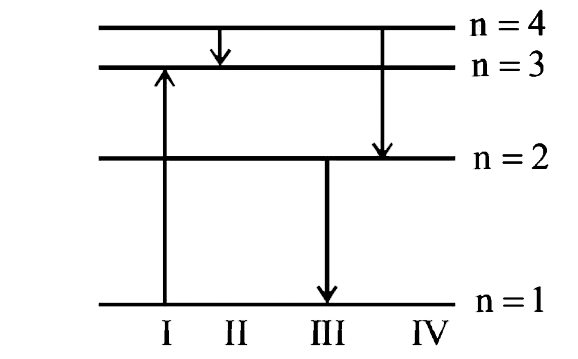
Q. The diagram (not drawn to scale) gives the first few electron energy levels within a single-electron atom. Which of the following gives the energy of a photon that could NOT be emitted by this atom during an electron transition?
17eV
42eV
64eV
255eV
The correct Answer is:B
The energies emitted during electron transition are equal to the differences between the allowed energy levels. Choice (A), 17 eV, is equal to the energy emitted by the photon when an electron drops from the -21 eV level to the -38 eV level. Choice (C). 64 eV is equal to the energy emitted by the photon when an electron drops from the -21 eV level to the -85 eV level. choice (D), 255 eV, is equal to the energyy emitted bythe photon when an electron drops from the -85 eV level to the -340 eV level. and (D), 302 eV, is equal to the energy emitted by the photon by the photon when an electron drops from the -38 eV level to the -340eV level. however, no electron transition in this atom could give rise to a 42 eV photon.
Topper's Solved these Questions
Similar Questions
The diagram shows the energy levels for an electron in a certain atom. Which transition shown represents the emission of photon with the most enegy ?

View SolutionShows the energy levels for an electron in a certain atom. Which transition shown represented the emission of a photon with the most energy?

View Solution
Knowledge Check
Which of the following phenomena suggests the presence of electron energy levels in atoms
ARadio active decayBIsotopesCSpectral linesDα−particles scatteringThe disgram shown the energy levels for an electron is a certain atom . Which transition shown the emission of a photon with the most energy ?
 AivBiiiCiiDi
AivBiiiCiiDiThe diagram shows the energy levels for an electron in a certain atom. Which transition shown represents the emission of a photon with the most energy ?
 AIIIBIVCIDII
AIIIBIVCIDII
The energy levels of a hypotherical one electron atom are shown in figure

Find the wave number of the photon emitted for the transition n=3→n=1
View SolutionThe diagram shows the energy levels for an electron in a certain atom. Which transition shown represents the emission of a photon with the most energy ?

View SolutionThe diagram shows the energy levels for an electron in a certain atom. Which transition shown represents the emission of photon with the most enegy ?

View SolutionThe diagram shows the energy levels for an electron in a certain atom. Which transition shown represents the emission of photon with the most enegy ?

View SolutionShows the energy levels for an electron in a certain atom. Which transition shown represented the emission of a photon with the most energy?

View Solution
